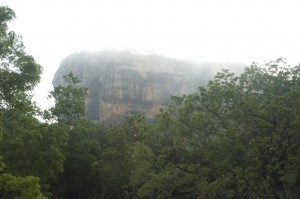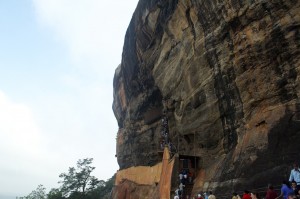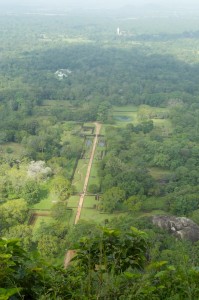Sri Lanka. I thought it was only Wales that had impossible to pronounce names. Sri Lanka comes a close second.
First impressions are very good. Coming out of the airport and driving along the new highway towards Colombo is like being in someone’s garden. The flowers and blossom stand out from everything green. The vegetation is so lush. The traffic is relatively light and there are clearly well observed rules of the road. It is not perfect, as I later found out, but it is nothing like India and Nepal for highway chaos. Traffic even stops at pedestrian crossings to allow people to cross the road without harm!
An English teacher working in Colombo told me a few years ago that the air was thick with pollution. Not a sign of it today; the first horticultural impressions proved correct as we drove through the centre of the city. Not only is it a green city with relatively clean air, but the streets are clean; there are no piles of rotting rubbish on every street corner. The pavements are solid and smooth and not likely to break your ankle the first time you venture out on foot. Is it possibly a case that Colombo and the government has made significant improvements. Since the civil war ended in 2009 soldiers have been redeployed on improving the infrastructure of the country with new roads, parkland areas etc. in fact the Ministry for War has been renamed the Ministry for War and Redevelopment.
Our journey from the airport to Maha and Indera’s flat took about 45 minutes. The warmth of their welcome, the cool of their ceiling fans, the icy cold water they offered us to drink, the refreshing shower and the tasty lunch was very welcome after our long, but plain sailing, journey from the UK.
After an early lunch, Priyal, our driver/guide collected us from the flat for the several hour drive to Sigiriya.
The journey from the airport might have seemed efficient but our afternoon road trip proved less so. The road for the volume of traffic was narrow. Varying speed limits according to the size of the vehicle became irrelevant as we were reduced to the speed of the slowest a lot of the time with few opportunities to overtake. For long stretches of the journey we were passing a ribbon of development, behind which there was lush, green vegetation, some of it cultivated with rice paddy fields populated with large numbers of egrets, but largely of tropical forest. To see forests of teak, mahogany and ebon was fabulous. Priyal, as well being our driver was a mine of information constantly pointing out features and places of interest. Some of the greenery belonged to coconut or rubber plantations.
As we approached the five hour mark I was expecting to see Sigiriya but there was absolutely no sign of it, even when we arrived at out hotel, one if the nearest to it there was no sign. Hotel Elephas only opened three months ago and has a number of two storey thatched blocks overlooking an inviting pool, so inviting that the first thing we did once we took possession of our room was to have a refreshing swim. Considering the temperature hovers around the low thirties at the moment the water was not as warm as I was expecting. It came as a bit of a shock but, once accustomed, was perfect.
Sitting on our terrace after a very satisfying meal the noises of the night made you feel as though you were suffering from a bad case of tinnitus with competing insects ringing in your ears.
Sleeping required choices to be made; sleep with the air conditioning on and endure the noise or sleep with it off and endure the heat. We chose the latter and had a remarkably good night’s sleep.
After an early breakfast we drove to Sigiriya along narrow dirt roads with lushness on either side. Kingfishers sat on wires and branches waiting for the opportunity to swoop in a flash of colour on to breakfast in the pools and ditches below.
Still there was no sign of of the rock we had come to see. How can a lump of rock so big be so invisible? Suddenly we were there, among a throng of tourists at the entrance to this World Heritage site. And there was the rock emerging from the early morning mist, a huge molar rising from the jungle.
We met our guide Samon and began our 200m, 1246 steps, climb to the top.
Sigiriya, translates to Lion Rock, is an ancient volcanic plug 370m above sea level. However, as impressive as it is, that is not the reason why it has become a World Heritage site. In the fifth century King Dhatusena in the north of the country had two sons, the eldest, Kaysapa being the result of a liaison with a concubine. When Kaysapa asked for his father’s kingdom he was told he could not have it and that his younger brother,Moggallana, would inherit the crown. Kaysapa, therefore asked for treasures instead. When his father offered him water, instead of the precious jewels he was hoping for and expecting, he became very angry and murdered him. Kaysapa felt it necessary to flee. He fled to Sigiriya. Over the next eighteen years he ruled his own kingdom and developed his fortress palace. He was a genius architect. Around the base of the rock he built two moats, the outer full of quicksand and the inner was not only five metres deep but inhabited by crocodiles.
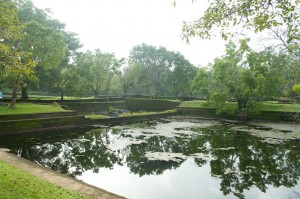 The path took us gently through layers of symmetrical gardens although only half had been excavated. The most distinctive was a water garden with a variety of pools. As we got closer to the rock the steps became more numerous and hugged the side of the rock face. Occasionally we came across caves. These were remarkable. The surface of the rock had been chipped away and then plastered with a mixture of things to allow frescos to be painted. Very little of them remain, having been weathered away over the centuries. Following the demise of Kaysapa Sigiriya was taken over by Buddhist monks for the next six centuries and although they didn’t approve of the subject matter in the frescos they preferred to let nature take its course rather than they vandalise them. These fresco caves were designed in such detail that there was a drip sill above them preventing water from getting to them and ultimately damaging them.
The path took us gently through layers of symmetrical gardens although only half had been excavated. The most distinctive was a water garden with a variety of pools. As we got closer to the rock the steps became more numerous and hugged the side of the rock face. Occasionally we came across caves. These were remarkable. The surface of the rock had been chipped away and then plastered with a mixture of things to allow frescos to be painted. Very little of them remain, having been weathered away over the centuries. Following the demise of Kaysapa Sigiriya was taken over by Buddhist monks for the next six centuries and although they didn’t approve of the subject matter in the frescos they preferred to let nature take its course rather than they vandalise them. These fresco caves were designed in such detail that there was a drip sill above them preventing water from getting to them and ultimately damaging them.
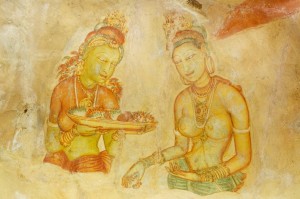 A little higher up, just above the mirrored wall, there is a spiral staircase leading up to an otherwise inaccessible shelf and shallow cave. Here the frescos are largely unscathed and they are fabulous. How they have managed to maintain such quality when they are over 1500 years old is incredible. Predictably, when they were commissioned by a man with over 500 concubines, the subject matter has a certain appeal to the male of the species, but the quality of the paintings is outstanding.
A little higher up, just above the mirrored wall, there is a spiral staircase leading up to an otherwise inaccessible shelf and shallow cave. Here the frescos are largely unscathed and they are fabulous. How they have managed to maintain such quality when they are over 1500 years old is incredible. Predictably, when they were commissioned by a man with over 500 concubines, the subject matter has a certain appeal to the male of the species, but the quality of the paintings is outstanding.
Returning to the mirrored wall via a second spiral staircase we continued our climb. The mirrored wall is in fact highly polished plaster-work which held three functions 1. to reflect the images of the frescos 2. so Kaysapa could not be seen from below and 3. this was probably the most exposed part of the climb and it offered protection. Today we are not allowed under any circumstances to touch the wall but throughout its occupied history people have written on it it minute writing. This has given archeologists an insight into the lives of those people and a greater understanding of events.
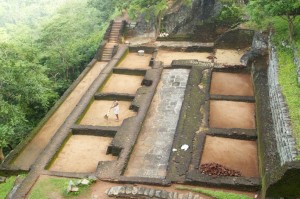 Just before the final climb to the summit there is a partially excavated area showing the site of the barracks for the soldiers who defended the rock. Just beyond, raised on small rock pillars is a piece of rock the size of a small house. Should any invaders manage to get beyond the moats the supports would be removed to send the rock crashing down on to the enemy below. The fact that it is still there is great testament to both the skills of those who created it and to the defence of the rock.
Just before the final climb to the summit there is a partially excavated area showing the site of the barracks for the soldiers who defended the rock. Just beyond, raised on small rock pillars is a piece of rock the size of a small house. Should any invaders manage to get beyond the moats the supports would be removed to send the rock crashing down on to the enemy below. The fact that it is still there is great testament to both the skills of those who created it and to the defence of the rock.
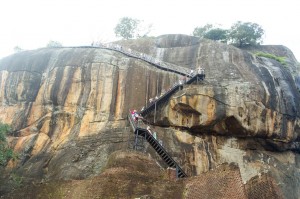 The final climb is up a metal stairway to a series of terraces, the highest showing the foundations of the King’s palace. Another contained a pool for his bathing and so on. On a clear day the view might have been spectacular in every direction, although it would be fair to say that it was very similar whichever way you looked – jungle. To one side, making it different from all others, was a giant statue of Buddha, rising a brilliant white above the green canopy. But the view was let down a little by the developing heat haze.
The final climb is up a metal stairway to a series of terraces, the highest showing the foundations of the King’s palace. Another contained a pool for his bathing and so on. On a clear day the view might have been spectacular in every direction, although it would be fair to say that it was very similar whichever way you looked – jungle. To one side, making it different from all others, was a giant statue of Buddha, rising a brilliant white above the green canopy. But the view was let down a little by the developing heat haze.
Everything we had seen, the gardens, the defence mechanisms, the staircases, the pools, the magnificent frescos, the palaces and all that came with it was created in just eighteen years. When Kaysapa killed his father the younger son and rightful heir, Moggallana, fled to Southern India fearing he might suffer the same fait. In 495, after eighteen years he managed to muster an army to seek revenge on his brother. Kaysapa, wishing to protect Sigiriya and prevent any army from coming close took his army several kilometres away to meet the attackers. Kaysapa and all the top military allies rode into battle on elephant back followed by an army of foot soldiers. It had rained heavily the night before and the elephants slipped dangerously in the mud. As the elephants withdrew the foot soldiers believed they had already been defeated and fled. Kaysapa, was abandoned so rather that suffer capture and the consequences there after ,he threw himself on to his sword and killed himself.
Whatever you think of Kaysapa as a person, a son and a king, he was a brilliant architect with a vision and imagination to be admired.
With the collapse of the Kingdom Buddhist monks took occupation if Sigiriya for the next six hundred years. After that it was abandoned and left to the jungle for several hundred years until it was discovered by the English explorer and archeologist, H.C.P. Bell, in 1890. By then it was completely consumed by the forest. The fact that we struggled to see it until we were almost upon it suggests that the jungle did a good job in hiding it for so long.
A really fascinating story and visit well worth the journey.
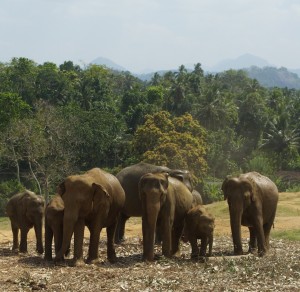 Meeting up with Priyal at the bottom of the rock we took to the road again and drove to the elephant orphanage at Pinnawala. Clearly a tourist attraction, we arrived in time for the baby feeding time held under an octagonal canopy. By the time we arrived most of the crowd had already gathered watching the five tethered babies swaying to and fro. I didn’t particularly enjoy seeing them tethered and behaving as though they wanted tone free. As Angela pointed out, we tether little children to a high chair for feeding whether they like it or not. The babies became much more compliant when the wardens came with a large pail of milk. This was transferred into a bottle with a rubber tube attached. The babies stood with mouths at the ready and one by one were issued several bottles, which they made very short work of.
Meeting up with Priyal at the bottom of the rock we took to the road again and drove to the elephant orphanage at Pinnawala. Clearly a tourist attraction, we arrived in time for the baby feeding time held under an octagonal canopy. By the time we arrived most of the crowd had already gathered watching the five tethered babies swaying to and fro. I didn’t particularly enjoy seeing them tethered and behaving as though they wanted tone free. As Angela pointed out, we tether little children to a high chair for feeding whether they like it or not. The babies became much more compliant when the wardens came with a large pail of milk. This was transferred into a bottle with a rubber tube attached. The babies stood with mouths at the ready and one by one were issued several bottles, which they made very short work of.
In an adjoining enclosure was a very sorry sight. A mature elephant was leaning awkwardly against a support, the lower part of its front right leg missing. It had stepped on a land mine. Without a functioning limb there was very little it could do and you couldn’t help but wonder how much better it would have been for the animal if it had been killed.
At the top of a small rise was an open area giving a panoramic view of the forested hills around. Here, the elephants looked more at home in this environment against this backdrop. The spectacle improved further when, perhaps as many as thirty elephants, came running up the hill towards us. This is what it should be like in a natural environment.
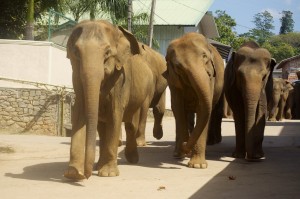 Next on the agenda for the elephants was bathing in the river. Next for us was lunch in a restaurant overlooking the bathing spot. The spectacle of fifty or so elephants almost running in their enthusiasm down the shop-lined street to the river was fabulous. I stood in the road to photograph the spectacle but soon realised that I was in danger of being trampled. Shortly after I retreated one small elephant crashed into the fencing around our restaurant much to the surprise of the diners sitting the other side of it. Fortunately it was robust and took the hit.
Next on the agenda for the elephants was bathing in the river. Next for us was lunch in a restaurant overlooking the bathing spot. The spectacle of fifty or so elephants almost running in their enthusiasm down the shop-lined street to the river was fabulous. I stood in the road to photograph the spectacle but soon realised that I was in danger of being trampled. Shortly after I retreated one small elephant crashed into the fencing around our restaurant much to the surprise of the diners sitting the other side of it. Fortunately it was robust and took the hit.
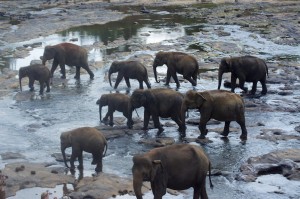 Once they reached the water their enthusiasm seemed to wane and most just stood around in the water up to their knees in a huddle. They looked like reluctant swimmers standing in the shallow end chatting. Despite the lack of activity it really was a spectacle to see so many elephants together.
Once they reached the water their enthusiasm seemed to wane and most just stood around in the water up to their knees in a huddle. They looked like reluctant swimmers standing in the shallow end chatting. Despite the lack of activity it really was a spectacle to see so many elephants together.
Lunch, and the elephant spectacle over we drove for a further two hours to Negombo, on the coast north of Colombo. We were staying in the Paradise Beach Hotel with a room looking out on the garden with the beach and sea beyond. We took a stroll along the golden sand as the sun set.
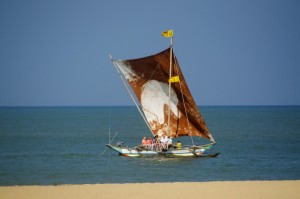 Following an excellent and long night’s sleep we only just made it to breakfast before the restaurant closed. The remainder of the morning was spent relaxing in the gardens, swimming and enjoying the warmth the climate provides.
Following an excellent and long night’s sleep we only just made it to breakfast before the restaurant closed. The remainder of the morning was spent relaxing in the gardens, swimming and enjoying the warmth the climate provides.
All too soon Priyal arrived to return us to Maha and Indira in Colombo.
At about 4.00pm as the intense heat was beginning to subside, Maha took us on a guided tour of the city. Again all my preconceived ideas about Colombo were shattered. It is a garden city with many fine building dating back to the British colonial rule. These have all been carefully renovated and look really good. Colombo is work in progress. For thirty years money had been directed to fighting the Tamil Tigers. Since the war ended in 2009 there has been money available to improve and develop Colombo into a thriving city. Foreign investors are clammering for part of the action and there is a lot of Chinese interest. Colombo will become the new Singapore. The famous Galle district on the waterfront will be fabulous, although it will take some years for its potential to be achieved.
In the centre of town the old racecourse has been developed and is now home to Colombo Rugby Club with a fine grandstand for spectators. The concept if Sri Lankans, who are naturally quite slight, playing rugby is hard to come to terms with. I guess what they lack in bulk will be more than compensated by speed and agility.
Another fascinating building is a new theatre and arts complex built within a framework that looks like a lotus flower. As well as internal theatre space it includes an open-air theatre on the roof, sufficiently high to avoid the noise of the city below.
In the evening Maha and Indira took us to Raja Bojun, a typical Sri Lankan fair restaurant. There is no menu, just a buffet with so many choices, all of which have to be tried, from egg hoppers, a hemisphere of wafer thin batter with an egg in the middle, a wide range of curries and accompaniments to very sweet sweets. It was a real feast and an excellent recommendation for Sri Lankan cuisine.
We are extremely grateful to Maha and Indira for their hospitality and for Maha coordinating out time in Sri Lanka. It was not long enough but, having dipped my toe in the water, I would not hesitate to return, and for much longer next time.
Next stop Singapore.

